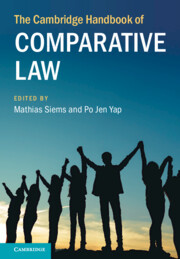Book contents
- The Cambridge Handbook of Comparative Law
- The Cambridge Handbook of Comparative Law
- Copyright page
- Contents
- Figures
- Tables
- Contributors
- Preface
- Abbreviations
- 1 Introduction
- Part I Methods of Comparative Law
- Part II Legal Families and Geographical Comparisons
- 11 Civil Law
- 12 Common Law
- 13 Confucian Legal Tradition
- 14 Former Soviet States of Eastern Europe, Caucasus and Central Asia
- 15 Latin America
- 16 Middle East and North Africa
- 17 South Asia
- 18 Sub-Saharan Africa
- Part III Central Themes in Comparative Law
- Part IV Comparative Law beyond the State
- Index
11 - Civil Law
from Part II - Legal Families and Geographical Comparisons
Published online by Cambridge University Press: 26 January 2024
- The Cambridge Handbook of Comparative Law
- The Cambridge Handbook of Comparative Law
- Copyright page
- Contents
- Figures
- Tables
- Contributors
- Preface
- Abbreviations
- 1 Introduction
- Part I Methods of Comparative Law
- Part II Legal Families and Geographical Comparisons
- 11 Civil Law
- 12 Common Law
- 13 Confucian Legal Tradition
- 14 Former Soviet States of Eastern Europe, Caucasus and Central Asia
- 15 Latin America
- 16 Middle East and North Africa
- 17 South Asia
- 18 Sub-Saharan Africa
- Part III Central Themes in Comparative Law
- Part IV Comparative Law beyond the State
- Index
Summary
This chapter develops along three lines. First, following a historical approach, it describes the birth and development of the civil law tradition – from the rediscovery of Roman law in the High Middle Ages to the enactment of the German Civil Code. The second part presents two cases where the civil law model has been transplanted outside of Europe: Latin America and Japan. The final part offers a critical outlook on what the civil law tradition means today.
- Type
- Chapter
- Information
- The Cambridge Handbook of Comparative Law , pp. 211 - 234Publisher: Cambridge University PressPrint publication year: 2024

